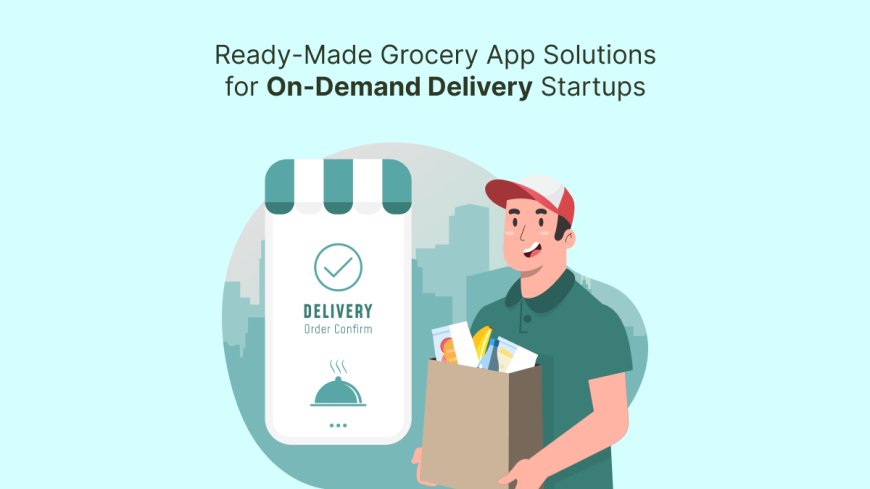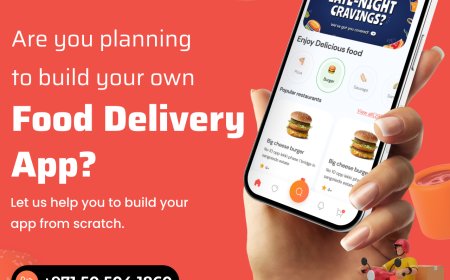Ready-Made Grocery App Solutions for On-Demand Delivery Startups
with our ready-made grocery app. Save on development time, launch quickly, and scale efficiently with powerful features.

The on-demand grocery delivery market is booming. With consumers expecting convenience at their fingertips, startups are racing to launch fast, reliable, and scalable grocery delivery platforms. But traditional grocery delivery app development from scratch requires significant time, money, and resourcessomething most startups dont have the luxury to spare.
By choosing a white-label grocery app, startups can enter the market quickly, reduce upfront costs, and focus on scaling their operations rather than building complex tech infrastructure. This blog explores how ready-made grocery apps work, the must-have features, monetization models, and why they're the best choice for startups looking to dominate the delivery space.
Why Choose a Ready-Made Grocery App?
Launching an on-demand business is hardbut building the entire tech stack shouldn't be. A ready-made grocery delivery app offers:
- Speed to Market: Launch in 12 weeks, not months.
- Cost Efficiency: Avoid spending tens of thousands on initial development.
- Proven Architecture: Built on scalable and tested frameworks.
- Custom Branding: Maintain your brand identity with design flexibility.
- Technical Support: Get post-launch updates and support from experienced teams.
Startups can instantly tap into a robust solution that has already been optimized for performance, UX, and monetizationwithout the usual development headaches.
Core Components of a Grocery Delivery Clone App
A powerful grocery app isn't just about product listings. Its an ecosystem that connects customers, delivery agents, and store owners seamlessly. Heres what your clone app should include:
1. Customer App
- Easy Sign-Up & Login: Email, phone, or social login options.
- Smart Search & Filters: Search by product name, category, or brand.
- Real-Time Order Tracking: Customers can track deliveries live.
- Multiple Payment Options: Credit/debit cards, wallets, UPI, COD.
- Order Scheduling: Let users schedule orders at a convenient time.
- In-App Chat Support: Real-time assistance when needed.
2. Delivery Partner App
- Order Management: View assigned orders and accept or reject.
- Navigation & Routing: Integrated GPS for quick delivery routes.
- Earnings Dashboard: Track daily, weekly, and monthly earnings.
- Notifications: Get alerts on order updates or new tasks.
3. Store/Marketplace App or Panel
- Product Management: Add/edit inventory, pricing, and categories.
- Order History: Track and manage incoming and completed orders.
- Promotions: Run discounts, offers, and loyalty programs.
- Inventory Status: Automatic updates to avoid stock-outs.
4. Admin Dashboard
- User Management: Monitor customers, vendors, and delivery agents.
- Revenue Reports: Get insights on sales, commissions, and growth.
- Commission Setup: Define earning rules from vendors and deliveries.
- CMS & Notification Tools: Control promotions, alerts, and app banners.
Key Features That Set a Good Grocery Clone App Apart
While many white-label grocery apps offer basic functions, standout features are what drive retention and revenue. Look for these advanced functionalities:
Multi-Store Support
Let users browse products from multiple stores and place mixed orders.
Read More: Take the Lead on the Market with Grocery Delivery App Solution!
Zone-Based Pricing
Control delivery charges based on customer location.
Wallet Integration
Allow customers to top-up wallets and earn cashback or loyalty points.
Real-Time Analytics
Use data insights to optimize performance and improve decision-making.
Multi-Language & Currency
Scale to international markets with ease.
How to Monetize Your Grocery Delivery App
A clone app isn't just a toolit's a business engine. Here's how you can generate revenue:
1. Delivery Charges
Charge customers based on distance, weight, or urgency.
2. Vendor Commission
Earn a percentage from each order placed via your partnered stores.
3. Subscription Plans
Offer premium services to customers like free delivery or exclusive deals.
4. Advertising Space
Sell ad spots in-app to grocery brands and local retailers.
5. Surge Pricing
Charge extra during peak hours or holiday rush periods.
Cost to Launch a Grocery Clone App
The cost of launching your grocery delivery app depends on several factors:
|
Development Aspect |
Estimated Range |
|
White-label clone app |
$4,000 $8,000 |
|
Design customization |
$500 $1,500 |
|
Third-party integrations |
$300 $1,000 |
|
Hosting & server setup |
$100 $500/month |
|
Ongoing maintenance & support |
$500 $1,000/month (optional) |
By using a clone solution, you eliminate 6070% of the costs and time compared to building from scratch.
Why Ready-Made Solutions Are Ideal for Startups
Grocery clone apps are startup-friendly for many reasons:
- Fast ROI: Start earning within weeks of launch.
- Low Technical Barriers: No need for a full-time in-house dev team.
- Flexibility: Add new features or services like pharmacy or flower delivery.
- Market-Tested Features: Clone apps are based on successful models like Instacart and BigBasket.
- Scalability: Handle 100 to 10,000+ orders per day with the same platform.
How to Choose the Right Development Partner
Not all clone app providers are equal. Heres how to pick the right one:
- Experience with On-Demand Apps: Check portfolio and client reviews.
- Source Code Ownership: Ensure you get full access post-deployment.
- Post-Launch Support: Updates, fixes, and feature upgrades are critical.
- Custom Add-Ons: Choose a provider that allows integrations like CRM, analytics tools, and more.
- Scalability Options: Pick a tech stack that grows with your business.
Launching & Scaling Tips for Success
Just launching a grocery app isnt enough. Heres how to grow sustainably:
- Start Local: Focus on one city or area before expanding.
- Partner with Local Stores: Onboard vendors who already have loyal customers.
- Offer Great UX: Smooth checkout, fast delivery, and customer service matter.
- Use Promotions: First-order discounts, referral bonuses, and cashbacks.
- Analyze Regularly: Use performance metrics to make smart decisions.
Conclusion
A ready-made grocery delivery app is the fastest and most efficient way for startups to enter the competitive on-demand delivery space. With powerful features, flexible monetization, and scalability baked in, you can focus on business strategy instead of technical challenges.
Choosing the right app development company will ensure your platform is reliable, future-ready, and capable of turning local demand into long-term growth.
FAQs
Q1. Can I customize the grocery clone app to match my brand?
Yes, white-label apps allow full design and feature customization based on your business needs.
Q2. Is this solution scalable if I want to expand to more cities?
Absolutely. These apps are built to scale across cities and even countries with zone and language support.
Q3. What payment gateways can be integrated?
Most popular payment gateways like Stripe, Razorpay, PayPal, and regional solutions can be added.
Q4. Do I need a separate app for store vendors and delivery agents?
Yes, a full solution includes separate apps or dashboards for customers, vendors, and delivery partners.
Q5. How long does it take to launch?
With a white-label grocery app, you can launch within 714 days depending on the customization.










































